Abstract
The decrease in grain plantation areas poses a growing concern for global food security. China, with its large population, increasingly diversified food demands, and relatively small cultivated lands, has suffered deeply from this phenomenon (non-grain production, NGP) in recent years. Since 2020, the central government of China has claimed to deal with this problem by attracting agriculturalists and organizations involved in grain plantation. In this context, understanding the global NGP of the national situation is vital for policy making. Remote sensing is regarded as the most effective and accurate method for this purpose, but existing studies have mainly focused on algorithms operating at the local scale or exploring grain-producing capability from the perspective of agricultural space. As such, the characterization of NGP on a national scale remains deficient. In this study, we tried to bridge the gap through spatio-analysis with a newly published nationwide crop pattern and land use geo-datasets; the quantitative, spatial, and structural features, as well as the utilization of NGP cropland in the year 2019, were observed. The results showed that about 60% of the cropland was used for non-grain plantation. About 15% of the NGP parcels were cultivated with grains at least three times in the past 4 years, and of these 60% and 40% were parcels with double- or single-season plantation, respectively, which could result in a 16–22% increase in the grain-sown area compared with 2019. Forest and grassland were the dominant non-cropping categories which NGP cropland transferred into, indicating more time and economic cost for regaining grains. NGP parcels also presented spatio-heterogeneity regarding cropping intensity and transformation. Parcels with double-season plantation mostly emerged in northern, central, and southern provinces, while those with single-season plantation were always located in northeastern and western provinces. The parcels that were transferred into forest or grassland mainly appeared in southern and Inner Mongolia, respectively, while the parcels in northern and central areas mostly continued cropping. According to these results, we propose remediation policies focusing on raising the cropping intensity of cultivated land in central and northern provinces due to their advantages of water, heat, terrain, and land use change features. Future work is warranted based on this study’s deficiencies and uncertainties. As a forerunner, this study provides a holistic observation of the NGP phenomenon in mainland China on a national scale, and the findings can inform improvements in land use policies concerning grain production and food security in China.
1. Introduction
Food security is essential for economic development and social stability. However, with more frequent extreme weather and natural disasters as well as regional conflicts, there is increasing instability in the global food supply [1,2]. In recent decades, despite the continuous rise in grain output, China still sees heavier dependence on imported grain as demand grows faster than supply, which is the result of improvements in people’s living standards [3]. Meanwhile, there is less arable land that is used for producing grains. According to the recently released results of the Third National Land Resource Survey, China’s cultivated lands decreased by 7.53 million hectares between 2009 and 2019 [4]. Cultivated lands not for grain production (short for NGP) may account for over a quarter of the total. The proportion may be higher at the local level, especially in cities with economic advantages or under rapid transformation [5].
Since the 2010s, the Chinese central government has attached great importance to this issue and has proclaimed a series of policies [6]. The key goal of the policies, namely, to expand grain (rice, wheat, and maize) cropping, should be achieved in a manner fitting local development levels. Therefore, understanding the quantitative, spatial, and structural features and the potential for NGP (non-grain production) consolidation will fundamentally contribute to the precise execution of policies. Considering the rapidity of interannual change in land use including NGP, remote sensing is regarded as the most effective and accurate way to capture information. Xiao et al. made what was probably the first effort to extract cash crops, a key type of NGP [7]. Taking multiple cropping into consideration, Yang et al. distinguished seasonal and annual NGP with phenology [8]. Furthermore, He et al. specifically classified NGP types (i.e., fishery, fruit, and greenhouse industries) [9]. All of these studies used high-resolution remote sensing images on a local scale and mainly discussed the algorithms for extracting NGP parcels from cropland. However, the variety of NGP types such as cash crop planting, aquatic livestock, and poultry breeding makes methods for their extraction difficult to apply extensively on a regional or larger scale, which means that the macro-spatial observation of NGP remains deficient. Meanwhile, the potentiality of or demand for the sown area and production of grains are always highlighted when discussing NGP consolidation; for example, Qiu et al. [10] estimated the increasing capability of grain production based on the temporal–spatial evolution of grain plantation, while Pu et al. [11] evaluated the gap in grain-sown areas based on the prediction of domestic food demand. These studies have determined an ideal state for grain plantation. However, NGP is a phenomenon mainly driven by economic and social factors [12,13,14,15,16,17,18]; it is necessary to discuss the NGP phenomenon in the context of land use, but there are still few scholars who express concern about it.
Thus, to bridge these gaps, there are two parts to this study: (1) a description of the quantitative, spatial, and structural features of NGP in a benchmark (2019) of the Chinese mainland from a national perspective; (2) an elementary overview of grain plantation on NGP cropland from the perspective of land use. To be specific, we adopted nationwide crop pattern and land use maps with spatial analysis tools. NGP cropland’s distribution, transformation, and ability to regain grain plantation were observed from a temporal–spatial perspective to provide constructive suggestions for NGP governance and the food security of cultivated lands.
2. Study Area
Our study was conducted on the mainland of China (Figure 1). China ranks third in the world in terms of cropland area. However, with such a large population, its per capita area is much lower than the world average [19]. Croplands are mainly located in the Eastern and Central Plains of China, and eating habits can be roughly divided into two types based on the Qin–Huai Line: for a staple crop, the northern region prefers wheat while the southern prefers rice. Maize, though ranking lower than rice and wheat in the preferences for cereal, is widely used in stock raising and industries [11]. In recent years, the total area of cropland in China has fallen continuously, as have the area and proportion of cropland used for raising grains [20]. Because remote sensing technologies and spatial information on land use cover change (LUCC) have developed rapidly, LUCC has been discussed frequently on various scales. However, there were many fewer nationwide spatial observations on NGP before concern was expressed by the Chinese central government in the year 2020. It has to be mentioned that Qinghai and Tibet were not included in this study for the following three reasons: (1) there are few croplands; (2) the main crops or staple foods for people there are not rice, maize, or wheat; (3) the outputs of these three crops there make up a negligible proportion of the national total.
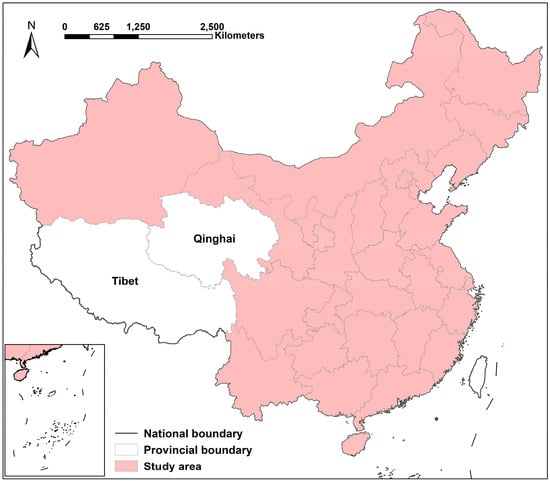
Figure 1.
Study area.
3. Technical Contents
3.1. Benchmark
First of all, a benchmark should be defined because the cropping behavior shows annual variation. The NGP problem started in the early 21st century and continued expanding during the 2010s [1]. In 2020, the Chinese government initiated a special campaign to deal with it [6]. Therefore, we chose 2019, one year before the campaign, as well as one of the years with the most serious NGP [13], as the benchmark.
3.2. Definition of NGP
Generally, cropland without grains, especially rice, wheat, or maize (short for “grains”) plantation, is defined as NGP. However, the calculation of NGP has not been unified to date. There two commonly used methods for describing NGP. One is the ratio of cropland without grain plantation to the area of total cropland [20]. Because it is not sensitive to cropping intensity, the ratio of the sown area of grains to the sown area of crops was introduced as an alternative, but it may overestimate the NGP ratio due to its inclusion of multiple-cropped non-grain crops rotated with grains when using statistics. In this study, we chose the first of these methods as the NGP indicator because the official documentation on NGP makes it clear that the consolidation of NGP should involve “inducing cropland cropping once grain cropping at least a year”. That is, two-season planting with one season for grain was considered normal crop rotation; only cropland with totally non-grain crop plantation was considered NGP (Table 1).

Table 1.
Definition of NGP.
3.3. Technical Routine
To achieve the goal of describing the features of NGP space and discussing the ability to restore grain plantation on NGP cropland, two questions need to be answered in turn: (1) to what extent, where, and how is the cropland used without grain cropping? (2) based on the results of question (1), where and to what extent can the NGP cropland regain grain plantation?
To answer the first question, a holistic perspective on the quantitative, spatial, and structural features of NGP in the benchmark was obtained from a map of crop patterns. To be specific, the area and ratio of NGP cropland on a national and provincial scale were both counted, as was NGP cropland with different cropping intensities. The statistical calculation was completed in ArcGIS 10.7 using the zonal statistics tool.
Ideally, all cropland can be used for grain plantation, but realistically, there are some blocking factors; for example, some croplands are used continuously for non-grain plantation, reasonable urban expansion, or political planning such as ecological protection [21]. Thus, an assessment of NGP cropland for grain plantation was designed for question (2). Firstly, NGP cropland with a slope >15° was excluded because it has been indicated as inadequate for cropping in Chinese official documents [22,23]. This step resulted in four kinds of NGP being included as follows: cropland with continuous non-grain plants, occasional grain plantation, continuous grain plantation but only in a fallow year in 2019, and newly developed NGP in the benchmark. Thus, in the second step, the frequency of the cropland used for grains before the benchmark was used as the indicator. Zero times means stable non-grain cropland that should be excluded, and the more times a parcel is planted with grains, the more seriously NGP governance should be considered for it. Because the fallow cycle is always 3–4 years in China, the time period chosen for this step was 2015–2018; we treated parcels with three or more instances of historical grain plantation as newly developed NGP or normal fallow, which are the dominant objectives in expanding the sown area of grains [6] (Figure 2).

Figure 2.
Capable NGP cropland for regaining grain plantation.
Because economic and time costs are always the factors that dominate behavior and priorities in NGP consolidation [13], the difficulty of regaining grain plantation in the PS (potential space for NGP consolidation) must be discussed. According to existing studies and the authors’ field work, there are five categories into which NGP mainly transferred: fishery, cash trees or shrubs, poultries, vegetable greenhouses, and abandoned. Among them, fishery, poultry, cash shrubs, and trees destroy the plow layer, thus necessitating more money and time to restore cropping [24,25]. Therefore, in this step, the transferred categories of PS were observed through land use maps after the benchmark. Because the transformation of cropland always needs 1 year or more, and the fallow or unstable grain plantation spaces may regain grain plantation in the following years, we adopted land use data between 2020 and 2023 and set the most frequent type in that period as the form of transformation. Notably, because the factors that affect the difficulty of NGP governance are always comprehensive, such as traffic conditions, the fragmentation of cropland, the inputs and outcomes of land, and the value of and compensation for land use change, this step can only provide a rough and directional indicator for NGP consolidation.
The last three steps were completed through space layer analysis between the NGP space obtained in (1) and terrain, crop pattern, and land use maps; the datasets used are introduced and presented in Section 3.4.
3.4. Data Acquisition and Preprocessing
3.4.1. Spatial Datasets of Grain and Cropland
The dataset for the distribution of rice, wheat, and maize in our study was called CPChina, produced by Qiu, a professor of the University of Fuzhou [26]. The original data were MODIS data (MOD09A1, 500 m 8-day composite surface reflectance product) including the spectral indices of the EVI (enhanced vegetation index), NMDI (normalized multi-band drought index), and LSWI (land surface water index), with a total accuracy of 90%. The dataset provided time-series spatial information for mainland China during the years 2015 to 2021, the years with the most serious NGP. There were 11 categories including (1) single paddy rice, (2) single maize, (3) single wheat, (4) other single cropping, (5) triple cropping, (6) maize–paddy rice, (7) winter wheat–maize, (8) double rice, (9) winter wheat–paddy rice, (10) fallow, and (11) other double cropping. According to the definition of categories in the dataset, we defined types (4) and (11) as “certain NGP”. Type (5) was labeled as “possible NGP” and discussed in advance, because in South China, multi-season planting may involve the triple cropping of rice or rice with other crops, or vegetable fields with continuous cropping.
3.4.2. Land Use Map
The data for land use change were produced by Huang et al. from the University of Wuhan [27] and have now been updated to the year 2023 (https://developers.google.com/earth-engine/datasets/catalog/MODIS_061_MCD12Q1#bands (accessed on 11 October 2024)). This dataset was extracted from over 330, 000 pieces of Landsat images taken during the years 1985 to 2023 from the Google Earth Engine, using the random forest method. The total accuracy was 80%. There were 17 categories of land use, with some being mosaics, such as cropland/natural vegetation mosaics. Referring to the official classification of land use in China and some long-time-series analyses [28,29], we combined them into eight categories to facilitate analyses: forest (corresponding to evergreen needle, deciduous and mixed forests, and woody savannas); shrubland (corresponding to closed and open shrublands); grassland; wetland; cropland; barren; waterbody; and mosaic (cropland and forest).
3.4.3. Ancillaries
A terrain map was obtained from the digital elevation model (DEM), which was downloaded from the Resource and Environmental Science Data Platform, Chinese Academy of Science. The DEM was abstracted from the Shuttle Radar Topography Mission (SRTM), with a high spatial resolution (30 m); its publication began in the year 2003, and it has been updated to version 4.1, which was the version used in this study. The administrative boundary of the study area was downloaded from the same platform.
3.4.4. Verification of Spatial Dataset
Before the analysis in Part 3.3, the compatibility between the land use and crop pattern datasets in the benchmark was verified because they came from different data resources and were established using different mathematical methods. A random sampling tool in ArcGIS was used for this, and 1000 samples were obtained and checked.
The results are displayed in Figure 3. More than 60% of the samples (618 samples) were cropland in both maps. Most of the inconsistent samples (about 90%) came from CPChina, which indicates that CPChina presents a wider extension on cropping. Upon comparing the consistency test results between similar cropland products (50–80%) [30,31,32], we deemed that the results of the comparison in this study were acceptable, and the error their inconsistency brought will be discussed in the Discussion Section.
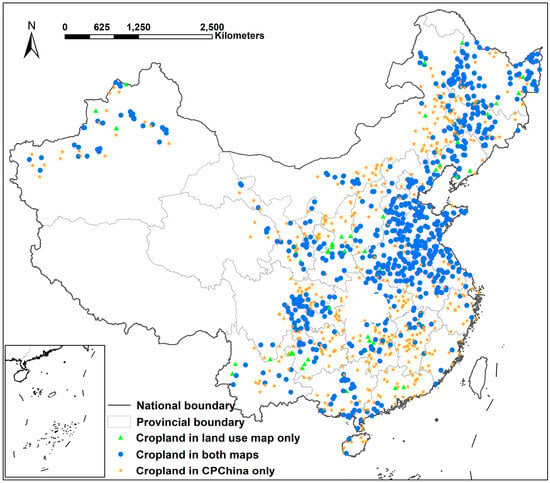
Figure 3.
Verification between cropland pattern and land use maps (2019).
4. Results
4.1. Quantitative, Spatial, and Structural Features of NGP in Benchmark
The effect of “triple” (TN, possible NGP with triple plantation) was ignored, as it accounted for only 1.70% and 2.77% of cropland and the combination of “triple”, “other single”, and “other double”, respectively. Among the provinces in our study, TN did not exist in most (two-thirds) of them. To be more specific, it accounted for 10% to 36% of the total in the five most southerly provinces (i.e., Guangxi, Guangdong, Fujian, Yunnan, and Hainan) and 1% to 5% in the south-central provinces (i.e., Hunan, Sichuan, Guizhou, Chongqing, and Jiangxi). We calculated the NGP with only “other single cropping” (SN, NGP with single-season plantation) and “other double cropping” (DN, NGP with double-season plantation). The results are displayed in Figure 4. In general, the national NGP level was 59.96% in the year 2019 and the non-grain cropping level of the northern part was higher than that of the southern. Beijing, the capital of China, ranked first in NGP level among all the provinces, while Hunan ranked the lowest, with 41.13%.
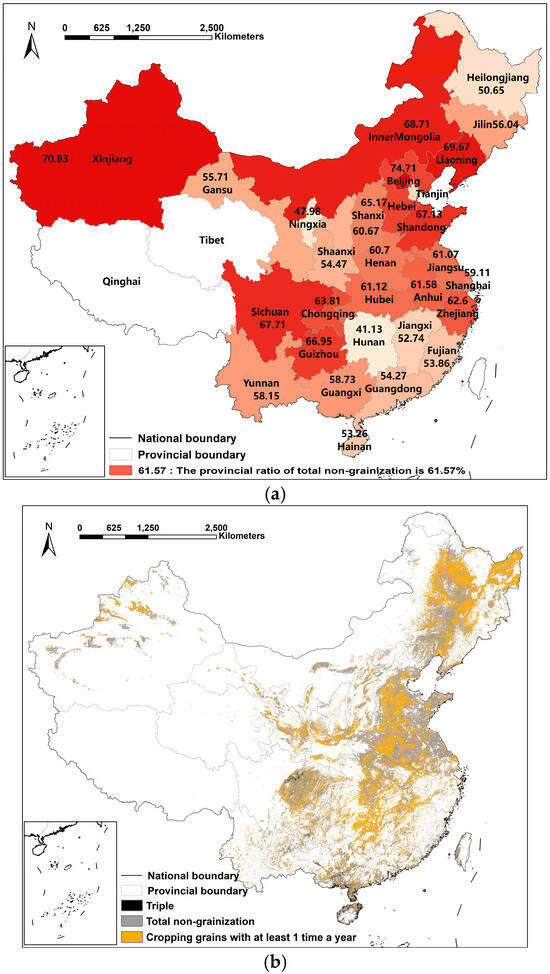
Figure 4.
Provincial ratios and distribution of NGP in the year 2019. Note: the deeper the color, the higher the NGP ratio that the corresponding province owns. (a) NGP ratios of provinces; (b) Distribution of NGP cropland.
We paid special attention to the five most southerly provinces mentioned above by comparing the NGP with or without TN as well as TN’s influence on their NGP ranking. Hainan, the top area for TN in China, may have witnessed an increase in NGP level from 53.25% to 82.76%. The other four may have seen increases of about 10% (from 7.06% to 12.87%) under the influence of TN (i.e., Yunnan: 7.06%; Guangxi: 11.86%; Guangdong: 11.91%; and Fujian: 12.87%). TN pixels greatly elevated the rankings of these 5 provinces but had a negligible impact on the other 24 provinces. In the following parts, we neglect TN to facilitate the discussion.
As mentioned before, SN and DN occupied at least 97.23% of the total non-grain cropland in mainland China, with DN dominantly accounting for 60%. At the same time, there was clear heterogeneity in their spatial distributions (Figure 5). SN was the dominant NGP in 14 provinces, most of which were in the northern part of China, with ratios from 56.03% to 100%. Among them, Hubei, Shandong, and Shaanxi were special, as their SN (42.73%~ 43.79%) and DN (56.03%~ 57.27%) were approximated to the national average. The other 11 provinces could be divided into four grades: (1) 100% (Heilongjiang and Jilin); (2) 90%~100% (Liaoning, Inner Mongolia, and Ningxia); (3) 80%~90% (Xinjiang, Beijing, and Shanxi); and (4) 70%~80% (Tianjin, Hebei, and Gansu) (Table 2).
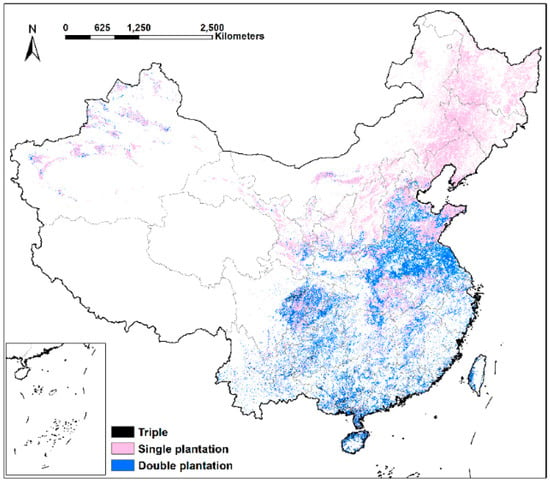
Figure 5.
Types of NGP in the year 2019.

Table 2.
Provincial NGP structures.
The DN was the dominant NGP in 15 provinces, most of which were in the southern part of China, with ratios of 55% to 89%. What should be mentioned is that the ratios of DN (the dominant one) were increased to different degrees due to the ignorance of “triple” (the inferior one). In addition, Henan, the main part of the North China Plain, was the only one in the north among the 15 provinces, with a higher ratio of DN compared with some southern regions, such as Hunan, Jiangxi, Sichuan, and Shanghai.
4.2. The Potential Space for Regaining Grains
After the screening of the slope, about 1.91% of the NGP plots were deemed unsuitable for cropping; more than 90% of these were distributed in mountainous provinces, especially Sichuan, Yunan, Guizhou, Chongqing, and southern Gansu. Among the remaining NGP cropland, areas with a frequency with grain plantation (FGP) of 0 to 4 times during 2015–2018 were 35.49%, 29.31%, 20.52%, 10.90%, and 3.67%, respectively (Figure 6). These results indicate that about 37% of NGP cropland is not suitable or should not be considered when expanding grain plantation.
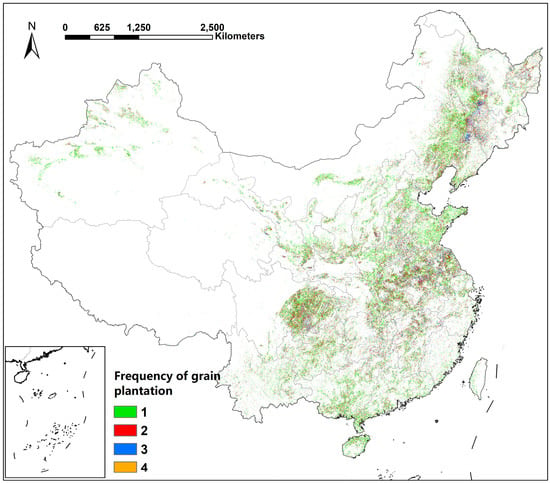
Figure 6.
Non-grainization cropland in 2019 with a slope over 15° or unstable grain plantation. Frequency of grain plantation on NGP area during 2015–2018.
The FGP in provinces showed similarity with the national FGP; that is, NGP plots with less than three instances of grain plantation were the absolute leading proportion in each province (72–97%) and ranked top (Figure 7a). Nevertheless, we did not find significant space clusters of any kind of NGP with each FGP level, but two different tendencies could still be observed: (1) grain plantation in major grain-producing regions tended to be more stable than that in minor ones, because the ratio of NGP plots with a high FGP in the former was always higher than that in the latter (Figure 7a), and (2) major grain-producing regions may be a major capable space for expanding grain plantation, because they also occupied more NGP parcels, especially high-FGP ones (Figure 7b).
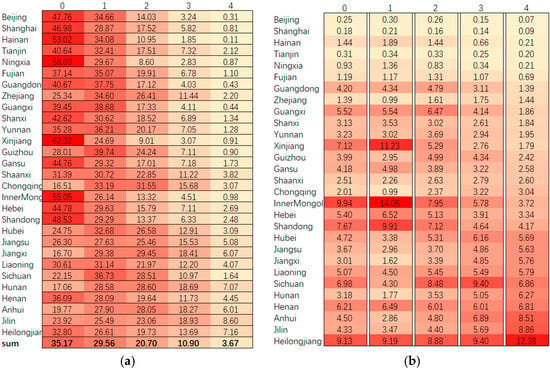
Figure 7.
Thermodynamic charts of the historical frequency of grain plantation on NGP cropland. (note: the deeper the color is, the higher value a province has). (a) Provincial distributions of NGP with stability scores; (b) Ratios of NGP with different stability scores in different provinces.
However, spatial heterogeneity was apparent when comparing the usage of NGP pixels of 2019 with that during the period from 2020 to 2023 (Figure 8). Firstly, more than half of NGP land (i.e., 50% of cropland and 10% of mosaic forest and cropland) retained its original land usage (cropland); this was mainly located in the northeast provinces and the North Plain. Secondly, grassland and forest were the secondary transferred usages of NGP cropland after 2019, with percentages of 23.08% and 15.87%, respectively. Transfer to grassland mainly occurred in the northwestern and northern parts, while that to forest mainly occurred in the southern part. The rest accounted for less than 0.5%.
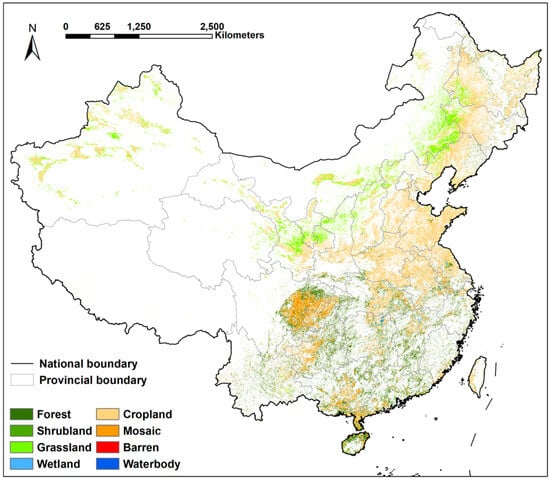
Figure 8.
The transformation of NGP land after the benchmark.
The observation at the provincial level revealed more details and consequently contributed to better targeted suggestions. We divided the 29 provinces into three groups (Table 3). The first group included 17 northern and central provinces where cropland was mainly used for plantation. The maximum, 96.82% in Shandong, means that nearly all the NGP remained original property in the years of consolidation. The minimum, 43.01% in Hubei, a value approximate to that of the second group, might indicate a quite different NGP trend or mode. Forest and grassland were the secondary dominant types in all provinces except Tianjin and Shanghai. However, forest held a favorable position, not only for having a higher ratio in 10 provinces compared with grassland in 6 provinces, but also for the fact that a forest–cropland “mosaic” would further increase the proportion of cropland and forest. Shanghai is a special case in this group, as waterbodies occupied a larger proportion (as secondary) of the transferred usage of NGP cropland. We speculated that this was the result of the transformation from agricultural plantation to fisheries. However, no direct evidence has been found.

Table 3.
Land use classes of NGP cropland transferred and their ratios after the benchmark.
The second group included the other provinces except Inner Mongolia, which are all mountainous. Among them, forest ranked top in nine provinces and the forest–cropland mosaic always ranked second or third. In other words, forest actually occupied a larger portion. The difference between the rest (i.e., Sichuan and Chongqing) and the former nine was that mosaic ranked top in these two provinces and there was not a large gap in the ratios between mosaic and forest, which ranked second. These mountainous provinces still held low but non-ignorable ratios of “cropland”, which we thought was related to the regional plains, including the Chengdu Plain in Sichuan, the Hangjiahu Plain in Zhejiang, the Poyang Plain in Jiangxi, and the Dongting Plain in Hunan. They are the main areas for grain production at the regional or even national level.
Inner Mongolia alone was the last group. It was the only province where grassland was dominant in NGP usage transfer, which was consistent with the conclusion of Kuang et al. on land use change [33]. There are two explanations. One is that China has continued restoring cropland for ecological conservation since the year 2000. The other is that, limited by natural conditions and population outflow, it is quite difficult for cropland to be transferred to forests and other types, which requires much more social and natural investment.
4.3. Quantifying the Potentiality of Expanding Grain Plantation
Based on the results in Section 4.2, about 15% of the NGP cropland retained stable grain plantation between 2015 and 2018, which can be the subject of focus for NGP consolidation. The spatial and quantitative features of the parcels are presented. Provincially, the ratios ranged from 3% to 18%. Provinces with lower ratios always have less NGP, to which less attention shall be paid. Under that circumstance, the existing cropland with grains (ECG) can be expanded by about 16%; the provincial areas of ECG will increase by 3.40% to 38.81%. The newly expanded space (NES) was mainly located in the east of the Heihe–Tengchong Line (the Hu Line), especially the central, northern, and northeastern provinces, where it accounted for more than 85%. Taking cropping intensity into consideration, the total ratio will increase to 22%. In that case, much more newly sown area will emerge in northern and central provinces, resulting in an evident southward move of the NES (Figure 9 and Table 4).
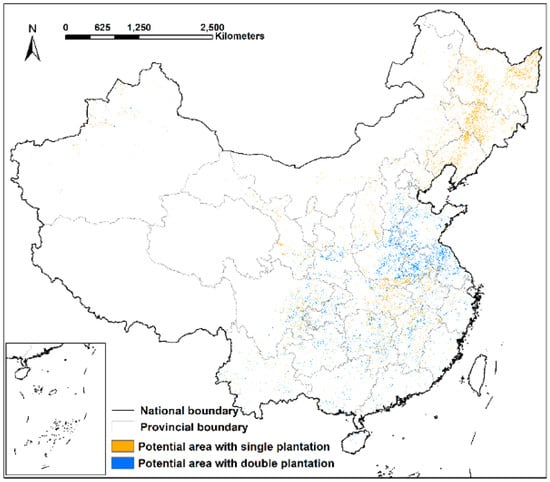
Figure 9.
Potential space for NGP consolidation.

Table 4.
Potential area for NGP consolidation.
5. Discussion
5.1. Possible Suggestions for NGP Governance
It is well known that the radical goal for NGP control is to secure the grain supply [34]. Because natural conditions alone cannot realize a remarkable rise in grain yields [35], it is vital to maintain or even expand sowing areas within a reasonable range and to upgrade management and technologies for better productivity [36]. There are two methods available to achieve this: one is to expand cropland, and the other is to raise cropping intensity [37].
Based on the results, we suggest paying more attention to the second method. In this context, we take the north and central provinces as the key regions for NGP governance based on four advantages: (1) Though blessed with great advantages in heat and water resources for two-season plantation, a fair proportion of the croplands there are cultivated only once a year, especially the plains [38,39]. (2) Flat terrains suit large-scale cultivation, which helps farmers and investors to achieve higher productivity with lower input [40,41]. (3) Most of the NGP lands there keep cropping (Table 3 and Figure 8). It is much easier to transfer land with plantations of flowers, vegetables, and herbs into grain land than to do the same for that used for forests, wetland, or waterbodies [42].
By contrast, the northeastern provinces (i.e., Heilongjiang, Jilin, Liaoning, and Inner Mongolia) could be alternatives with large potential space but limited heat (only suitable for one-season plantation) and water conditions. The additional cropland there in the past two decades was mainly transferred from grassland and wetland [21,43], casting negative influences on ecology and increasing the imbalances in the distribution of and demand for water resources [44]. Meanwhile, most of the newly developed croplands there were marginalized, with impoverished conditions, and high inputs only led to low outputs [33,45]. The northwestern area has also met similar problems, with much undeveloped land there [23].
The southern area can provide enough heat and water resources for increasing cropping intensity. However, a well-developed transportation system, better education, and a highly developed economy make farmers prefer non-agricultural work, which becomes more convenient [34,46]. Objectively, the fragmentation of mountainous cropland, leading to higher input but lower output, drove them into non-agricultural production [13,47]. Furthermore, the main NGP types in the southern area (i.e., forest and shrubs) destroyed plow layers, which made land reclamation and restoration more time- and resource-consuming [16].
5.2. Uncertainties and Future Work
The decline in grain plantation is a common phenomenon across the globe [48], but there is no unified calculation or criterion for its rectification, which makes the resistance to NGP controversial. Compared with the quantitative calculation of NGP based on statistics, remote sensing images provide more precise information on cropping intensity, which is always estimated in the former method, leading to diverse results [8]. However, the method is still prone to errors. Many of the main grain-producing provinces obtained a relatively high level of NGP because they had much more cropland as well. Meanwhile, the annual variations in croplands with or without grain plantation makes the observations of NGP incomparable between years or regions, as do the different contents of “grains” [30,49]. These deficiencies may mislead policy makers.
Therefore, we deem that an absolute index for evaluating NGP is worth discussing, such as the sown area or the total production of grains, as these can directly present the fluctuation in grain plantation and its influence on the grain supply and meet the core demands of NGP governance and food security; when the indicator decreases, NGP occurs. However, the central Chinese government does not provide local baselines for grain plantation or production, causing local executors to emphasize expanding sown areas only in NGP consolidation.
China actually reached the widely recognized goal of food security in 2006 (400 kg per capita a year) [19], and the yields and total production of grains have continued to increase in the following years. Though the constant growth of the population has partly counteracted the positive effects on individual grain supply, the evolution of the residents’ food pyramid has seen a decrease in the calories obtained from grains. Thus, there are also scholars advocating for a lowering of the standard of domestic self-supply and taking advantage of food allocation and trade. Therefore, it is essential to discuss NGP in the context of population flow and different food supply scenarios in future work.
From the perspective of land use change, there is a great proportion of NGP transferred into non-crop land use categories. This phenomenon may indicate challenges in driving these croplands back to grain plantation. Firstly, the categories are much more time- and money-consuming compared with those for non-grain edible vegetables, for which farmers tended to maintain NGP behavior [11]. Secondly, with the removal of plow layers and changes in physical and chemical properties, wetlands, waterbodies, and forests are no longer fit for grain plantation and cannot be recovered in the short term [21]. Furthermore, NGP has a space conglomeration effect, as farmers tend to follow once they see the benefits obtained by their forerunners [5]. Even though there has been much positive news about official intensive consolidation projects in recent years, less attention has been paid to the situation outside project regions and the influence of their interactions on NGP behavior or grain production.
Spatially, a coarse discussion on regaining grain plantation from the perspective of land use change is far from sufficient for practice. In recent years, China has put more emphasis on ecological protection and the intensive and economical use of natural resources. The environmental degradation and spatial mismatch caused by agricultural expansion in northeastern and western regions emerged in the early 2000s and are becoming worse [34]. Meanwhile, as a behavior mainly driven by economic benefit, forcibly re-establishing grains is likely to trigger resistance or even abandonment [9], which is the opposite of the original aim of land use policies. Thus, it is also necessary to explore a comprehensive framework for how NGP parcels could be mitigated.
Additionally, despite it being verified that the error between crop pattern and land use maps would not impact the main results and conclusions, the universal mixed-pixel problem of satellite images may introduce more uncertainties in mountainous and hilly provinces with fragmented cropland. In the verification between CPChina and the land use map used in this study, a higher inconsistency was observed in the southern area and the surroundings of the line dividing east and west. This appeared to exaggerate the transformation of NGP cropland into non-cropping usages. Therefore, special attention will be paid in our future work to newly developed maps with high resolution, such as NDCR and China-CUI10 [50,51,52].
6. Conclusions
The decline in grain plantation is a growing worldwide phenomenon which poses a great concern for the Chinese government and food security, but there is limited knowledge of it on a national scale. In this study, the gaps in our knowledge were initially addressed through spatio-analysis based on newly published crop pattern and land use maps. We quantified NGP cropland and its intensity across mainland China (except Tibet and Qinghai) in a benchmark (2019), as well as its spatial distribution. The probable space and extent for mitigating NGP was also discussed based on historical plantation and transformation on NGP plots. The main results are as follows: (1) Nearly 60% of cropland was used without grain plantation in 2019. (2) Blocks with double-season plantation took up 60% of NGP space and were mainly distributed in the southern area, while NGP blocks with single-season plantation were mainly located in the northeastern area. (3) In total, 37% of the NGP cropland is not recoverable for grains, due to political farming abandonment or continuous non-grain use, while about 15% could be focused on for NGP consolidation, which could increase the sown area of grains by 16–22%. (4) More than half of the NGP parcels retained cropping, which were mainly located in the northeastern provinces and the North Plain. (5) Grassland and forest were the dominant transferred usages of NGP cropland after 2019, with percentages of 23.08% and 15.87%, respectively; the transformation to grassland mainly occurred in the northwestern and northern parts, while the transformation to forest mainly occurred in the southern part. Based on the results, we regard the northern and central provinces as the key regions in NGP governance, due to their abundant water and heat resources, flat terrain, and lower costs for going back to grain cropping.
The study’s deficiencies and uncertainties prompt further suggestions and warrant further work. Primarily, an absolute indicator such as the sown area or total production of grains is advised for assessing NGP, because the commonly used indicators are not comparable between years and regions. In the context of a unified indicator for NGP, we propose discussions on NGP from the perspective of population flow, grain supply scenarios, and social–economic factors, which could help us to understand the effect of NGP on grain supply or NGP policy making. Last but not least, special attention should be paid to hilly and mountainous regions because the mixed-pixel problem may introduce more error in the results.
Author Contributions
Methodology, Y.L.; Writing—original draft, Y.L.; Writing—review & editing, G.S.; Funding acquisition, T.H. All authors have read and agreed to the published version of the manuscript.
Funding
This research was funded by the Natural Science Foundation of Zhejiang Province, China. Grant number: Q22D018818.
Data Availability Statement
The original contributions presented in this study are included in the article. Further inquiries can be directed to the corresponding author.
Conflicts of Interest
Author Yizhu Liu was employed by the company Zhejiang University Urban-Rural Planning & Design Institute, Co., Ltd. The remaining authors declare that the research was conducted in the absence of any commercial or financial relationships that could be construed as a potential conflict of interest.
References
- Wang, Y.; Chen, Y.J.; Yi, X.Y.; Xiao, B.L. The non-grain problem in the process of land transfer and the countermeasures. Chin. J. Agric. Resour. Reg. Plan. 2011, 32, 13–16. [Google Scholar]
- Prăvălie, R.; Patriche, C.; Borrelli, P.; Panagos, P.; Roșca, B.; Dumitraşcu, M.; Nita, I.-A.; Săvulescu, I.; Birsan, M.-V.; Bandoc, G. Arable lands under the pressure of multiple land degradation processes: A global perspective. Environ. Res. 2021, 194, 110697. [Google Scholar] [CrossRef]
- Sheng, Y.; Song, L. Agricultural production and food consumption in China: A long-term projection. China Econ. Rev. 2019, 53, 15–29. [Google Scholar] [CrossRef]
- The Release of the Third National Land Resource Survey. Available online: https://www.gov.cn/xinwen/2021-08/26/content_5633497.htm (accessed on 12 December 2024).
- Cheng, X.B.; Liu, Q.; Tao, T.; Liu, J.J.; Wang, F.; Tao, Q.; Ou, W.X. Non-grain production characteristics of cultivated land in rapidly urbanized regions and their mechanisms. China Popul. Resour. Environ. 2022, 32, 172–182. [Google Scholar]
- Opinions of the General Office of the State Council on Preventing “Non-Grain” of Cultivated Land and Stabilizing Grain Production. Available online: https://www.gov.cn/zhengce/content/2020-11/17/content_5562053.htm (accessed on 12 December 2024).
- Xiao, R.; Su, S.L.; Mai, G.C.; Zhang, Z.Y.; Yang, C.X. Quantifying determinants of cash crop expansion and their relative effects using logistic regression modeling and variance partitioning. Int. J. Appl. Erath Obs. Geoinf. 2015, 34, 258–263. [Google Scholar] [CrossRef]
- Yang, Y.; Yang, G.J.; Long, H.L.; Zhang, J.; Chen, W.N.; Gao, M.L.; Yang, Y. Multi-modal recognition method for non-grain cropland using remote sensing time series. Trans. Chin. Soc. Agric. Eng. 2024, 40, 283–294. [Google Scholar]
- He, T.T.; Jiang, S.Q.; Xiao, W.; Zhang, M.X.; Tang, T.; Zhang, H.Y. A non-grain production on cropland spatiotemporal change detection method based on Landsat time-series data. Land Degrad. Dev. 2024, 35, 3031–3047. [Google Scholar] [CrossRef]
- Qiu, B.W.; Jian, Z.Y.; Yang, P.; Tang, Z.H.; Zhu, X.L.; Duan, M.J.; Yu, Q.Y.; Chen, X.H.; Zhang, M.; Tu, P.; et al. Unveiling grain production patterns in China (2005–2020) towards targeted sustainable intensification. Agric. Syst. 2024, 216, 103878. [Google Scholar] [CrossRef]
- Pu, M.Z.; Zhou, L.; Zhong, Y.; Chen, M.S. Setting bottom lines for grain self-sufficiency in the grain production and consuming balancing areas and major grain consuming areas in China. Issues Agric. Econ. 2022, 7, 113–123. [Google Scholar]
- Feng, Y.B.; Ke, M.Y.; Zhou, T. Spatio-temporal dynamics of non-grain production of cultivated land in China. Sustainability 2022, 14, 14286. [Google Scholar] [CrossRef]
- Chen, F.; Liu, J.N.; Chang, Y.Y.; Zhang, Q.; Yu, H.C.; Zhang, S.L. Spatial pattern differentiation of non-grain cultivated land and its driving factors in China. China Land Sci. 2021, 35, 33–43. [Google Scholar]
- Zhang, D.; Yang, W.; Kang, D.; Zhang, H. Spatio-temporal charateristics and policy implication for non-grain production of cultivated land in Guanzhong Region. Land Use Policy 2023, 125, 106466. [Google Scholar] [CrossRef]
- Chang, Y.Y.; Liu, J.N.; Ma, J.; Yu, H.C.; Chen, F. Spatial pattern and driving factors of non-grain conversion on cultivated land in arid and semi-arid regions. J. Agric. Resour. Environ. 2023, 40, 333–344. [Google Scholar]
- Liang, X.; Jin, X.; Liu, J.; Yin, Y.; Gu, Z.; Zhang, J.; Zhou, Y. Formation mechanism and sustainable productivity impacts of non-grain croplands: Evidence from Sichuan Province, China. Land Degrad. Dev. 2023, 34, 1120–1132. [Google Scholar] [CrossRef]
- Hu, J.D.; Wang, H.; Song, Y. Spatio-temporal evolution and driving factors of non-grain production in Hubei Province based on a non-grain index. Sustainability 2024, 15, 9042. [Google Scholar] [CrossRef]
- Chen, X.B.; Tao, Y.; Huang, C.H.; Yi, J.L.; Yi, D.; Wang, F.; Tao, Q.; Xi, H.H.; Ou, W.X. Unraveling the Causal Mechanisms for Non-Grain Production of Cultivated Land: An Analysis Framework Applied in Liyang, China. Land 2022, 11, 1888. [Google Scholar] [CrossRef]
- FAO, World Food and Agriculture–Statistic Yearbook 2022. Available online: https://www.fao.org/statistics/en/ (accessed on 7 October 2024).
- Su, H.; Liu, F.; Zhang, H.; Ma, X.; Sun, A. Progress and prospects of non-grain production of cultivated land in China. Sustainability 2024, 16, 3537. [Google Scholar] [CrossRef]
- Chen, F.; Hua, Z.Y.; Ma, J.; Jiang, F.F.; Zhi, X.J.; Zhu, X.H. The influence of non-grain conversion of cultivated land on soil health and mechanism. Resour. Sci. 2023, 45, 2210–2221. [Google Scholar]
- Hao, S.H.; Wu, K.N.; Dong, X.R.; Yang, Q.J.; Gao, X.H. Identification criteria of cultivated horizon damage for non-grain cultivated land. Chin. J. Soil Sci. 2021, 52, 1028–1033. [Google Scholar]
- Yuan, C.C.; Zhang, D.X.; Liu, L.M.; Ye, J.W. Regional characteristics and spatial-temporal distribution of cultivated land change in China during 2009–2018. Trans. Chin. Soc. Agric. Eng. 2021, 37, 267–278. [Google Scholar]
- Ye, S.J.; Song, C.Q.; Cheng, C.X.; Gao, P.C.; Shen, S.; Mu, W.S. Five issues and countermeasures of China cropland resource use. Bull. Chin. Acad. Sci. 2023, 38, 1962–1976. [Google Scholar]
- Su, Y.; Li, C.L.; Wang, K.; Deng, J.S.; Shahtahmassebi, A.R.; Zhang, L.P.; Ao, W.J.; Guan, T.; Gan, M.Y. Quantifying the spatiotemporal dynamics and multi-aspect performance of non-grain production during 2000–2015 at a fine scale. Ecol. Indic. 2019, 101, 410–419. [Google Scholar] [CrossRef]
- Qiu, B.W.; Hu, X.; Chen, C.C.; Tang, Z.H.; Yang, P.; Zhu, X.L.; Yan, C.; Jian, Z.Y. Maps of cropping patterns in China during 2015–2021. Sci. Data 2022, 9, 479. [Google Scholar] [CrossRef] [PubMed]
- National Standardization Administration. Cultivated Land Quality Grade GB/T 33469-2016. 2016. Available online: https://www.sac.gov.cn/xw/bzhyw/art/2017/art_0d446a0b7faa4f92ae99bf724cc2187a.html (accessed on 12 December 2024).
- Yang, J.X.; Huang, X. The 30m annual land cover dataset and its dynamics in China from 1990 to 2019. Earth Syst. Sci. Data 2021, 13, 3907–3925. [Google Scholar] [CrossRef]
- Ning, J.; Liu, J.Y.; Kuang, W.H.; Xu, X.L.; Zhang, S.W.; Yan, C.Z.; Li, R.D.; Wu, S.X.; Hu, Y.F.; Du, G.M.; et al. Spatio-temporal patterns and characteristics of land-use change in China during 2010–2015. J. Geogr. Sci. 2018, 28, 547–562. [Google Scholar] [CrossRef]
- Lu, M.; Wu, W.B.; Zhang, L.; Liao, A.P.; Peng, S.; Tang, H.J. A comparative analysis of five global cropland datasets in China. Sci. China Earth Sci. 2016, 59, 2307–2317. [Google Scholar] [CrossRef]
- Yang, Y.K.; Xiao, P.F.; Feng, X.Z.; Li, H.X.; Chang, X.; Feng, W.D. Comparison and assessment of large-scale land cover datasets in China and adjacent regions. J. Remote Sens. 2014, 18, 464–475. [Google Scholar]
- Liu, Y.Z.; Wu, W.B.; Li, H.L.; Imtiaz, M.; Li, Z.L.; Zhou, Q.B. Intercomparison on four irrigated cropland maps in Mainland China. Sensors 2018, 18, 1197. [Google Scholar] [CrossRef]
- Kuang, W.H.; Zhang, S.W.; Du, G.M.; Yan, C.Z.; Wu, S.X.; Li, R.D.; Lu, D.S.; Pan, T.; Ning, J.; Guo, C.Q.; et al. Remotely sensed mapping and analysis of spatio-temporal patterns of land use change across China in 2015-2020. Acta Geogr. Sin. 2022, 77, 1056–1071. [Google Scholar]
- Chen, S.C.; Zhang, Y.N.; Zhu, Y.L.; Ma, L.; Zhao, J.H. The battle of crops: Unveiling the shift from grain to non-grain use of farmland in China? Int. J. Agric. Sustain. 2023, 21, 2262752. [Google Scholar] [CrossRef]
- Yan, H.M.; Ji, Y.Z.; Liu, f.; Hu, Y.F.; Kuang, W.H. Potential prompted productivity and spatial patterns of medium and low–yield cropland in China. J. Geogr. Sci. 2016, 26, 259–271. [Google Scholar] [CrossRef]
- Gao, Y.K.; Zhao, H.F.; Zhao, C.; Hu, G.H.; Zhang, H.; Liu, X.; Li, N.; Hou, H.Y.; Li, X. Spatial and temporal variations of maize and wheat yield gaps and their relationships with climate in China. Agric. Water Manag. 2022, 270, 107714. [Google Scholar] [CrossRef]
- Tan, G.W.; Wang, X.D.; Wang, J.M.; Mei, X.R.; Liu, X. National food security strategy in the new situation. China Eng. Sci. 2023, 25, 1–13. [Google Scholar] [CrossRef]
- Zhang, M.; Wu, B.; Zeng, H.; He, G.; Liu, C.; Tao, S.; Zhang, Q.; Nabil, M.; Tian, F.; Bofana, J.; et al. GCI30: A global dataset of 30 m cropping intensity using multisource remote sensing imagery. Earth Syst. Sci. Data 2021, 13, 4799–4817. [Google Scholar] [CrossRef]
- Tao, J.B.; Zhang, X.Y.; Liu, Y.Q.; Jiang, Q.Y.; Zhou, Y. Estimating agricultural cropping intensity using a new temporal mixture analysis method from time series MODIS. Remote Sens. 2023, 15, 4712. [Google Scholar] [CrossRef]
- Wang, L.Y.; Zhang, S.Y.; Xiong, Q.Q.; Liu, Y.; Liu, Y.F.; Liu, Y.L. Spatiotemporal dynamics of cropland expansion and its driving factors in the Yangtze River Economic Belt: A nuanced analysis at the county scale. Land Use Policy 2022, 119, 106168. [Google Scholar] [CrossRef]
- Ma, J.K.; Li, G.S.; Li, N. Non-grain or grain0oriented: The influence of farmland management scale on planting structure. Chin. J. Agric. Resour. Reg. Plan. 2023, 44, 90–100. [Google Scholar]
- Wang, S.L.; Jin, X.B.; Zhang, X.X.; Shi, S.; Shi, Y.C.; Liu, J.; Zhou, Y.K. Potential and differentiated control of non-grain cultivated land consolidation in major grain producing areas: A case study of the Chengdu Plain. Prog. Geogr. 2023, 42, 2172–2185. [Google Scholar] [CrossRef]
- Chen, F.; Liu, J.N.; Guo, W.H.; Ma, J.; Yang, B.; Zhu, X.H. Spatio-temporal pattern changes and interfering factors of transferred farmland in China in the past 20 years. Resour. Environ. Yangze Basin 2024, 33, 1793–1804. [Google Scholar]
- Zuo, L.J.; Zhang, Z.X.; Carlson, K.M. Progress towards sustainable intensification in China challenged by land-use change. Nat. Sustain. 2018, 1, 304–313. [Google Scholar] [CrossRef]
- Zhang, B.L.; Sun, P.L.; Jiang, G.H.; Zhang, R.J.; Gao, J.B. Rural land use transition of mountainous areas and policy implications for land consolidation in China. J. Geogr. Sci. 2019, 29, 1713–1730. [Google Scholar] [CrossRef]
- Zhang, B.L.; Gao, J.B.; Gao, Y.; Cai, W.B.; Zhang, F.R. Land use transition of mountainous rural areas in China. Acta Geographic Sinica 2018, 73, 503–517. [Google Scholar]
- Zhang, Y.S.; Feng, Y.F.; Wang, F.; Chen, Z.L.; Li, X.H. Spatiotemporal differentiation and driving mechanism of cultivated land non-grain conversion in Guangdong Province. Resour. Sci. 2022, 44, 480–493. [Google Scholar] [CrossRef]
- Xie, H.L.; Ouyang, Z.Y.; Chen, J.R. Does Cultivated Land Fragmentation Promote “Non-grain” Utilization of Cultivated Land: Based on a Micro Survey of Farmers in the Hilly and Mountainous Areas of Fujian. China Land Sci. 2022, 36, 47–56. [Google Scholar]
- Xu, C.; Guo, J.; Yi, J.L.; Ou, M.H. Analysis on the evolution of spatiotemporal pattern and driving factors of non-grain cultivated land in Jiangsu Province from 1996–2020. Resour. Environ. Yangze Basin 2024, 33, 436–447. [Google Scholar]
- Cai, Z.; Hu, Q.; Zhang, X.; Yang, J.; Wei, H.; Wang, J.; Zeng, Y.; Yin, G.; Li, W.; You, L.; et al. Improving agricultural field parcel delineation with a dual branch spatiotemporal fusion network by integrating multimodal satellite data. ISPRS J. Photogramm. 2023, 205, 34–49. [Google Scholar] [CrossRef]
- Pan, B.H.; Zheng, Y.; Shen, R.Q.; Ye, T.; Zhao, W.Z.; Jie, D.; Ma, H.Q.; Yuan, W.P. High Resolution Distribution Dataset of Double-Season Paddy Rice in China. Remote Sens. 2021, 13, 4609. [Google Scholar] [CrossRef]
- Qiu, B.W.; Lu, B.L.; Tang, Z.H.; Dong, J.W.; Xu, W.M.; Liang, J.Z.; Chen, N.; Chen, J.P.; Wang, L.G.; Zhang, C.M.; et al. National-scale 10m maps of cropland use intensity in China during 2018–2023. Nat. Sci. Data 2024, 11, 691. [Google Scholar] [CrossRef]
Disclaimer/Publisher’s Note: The statements, opinions and data contained in all publications are solely those of the individual author(s) and contributor(s) and not of MDPI and/or the editor(s). MDPI and/or the editor(s) disclaim responsibility for any injury to people or property resulting from any ideas, methods, instructions or products referred to in the content. |
© 2025 by the authors. Licensee MDPI, Basel, Switzerland. This article is an open access article distributed under the terms and conditions of the Creative Commons Attribution (CC BY) license (https://creativecommons.org/licenses/by/4.0/).